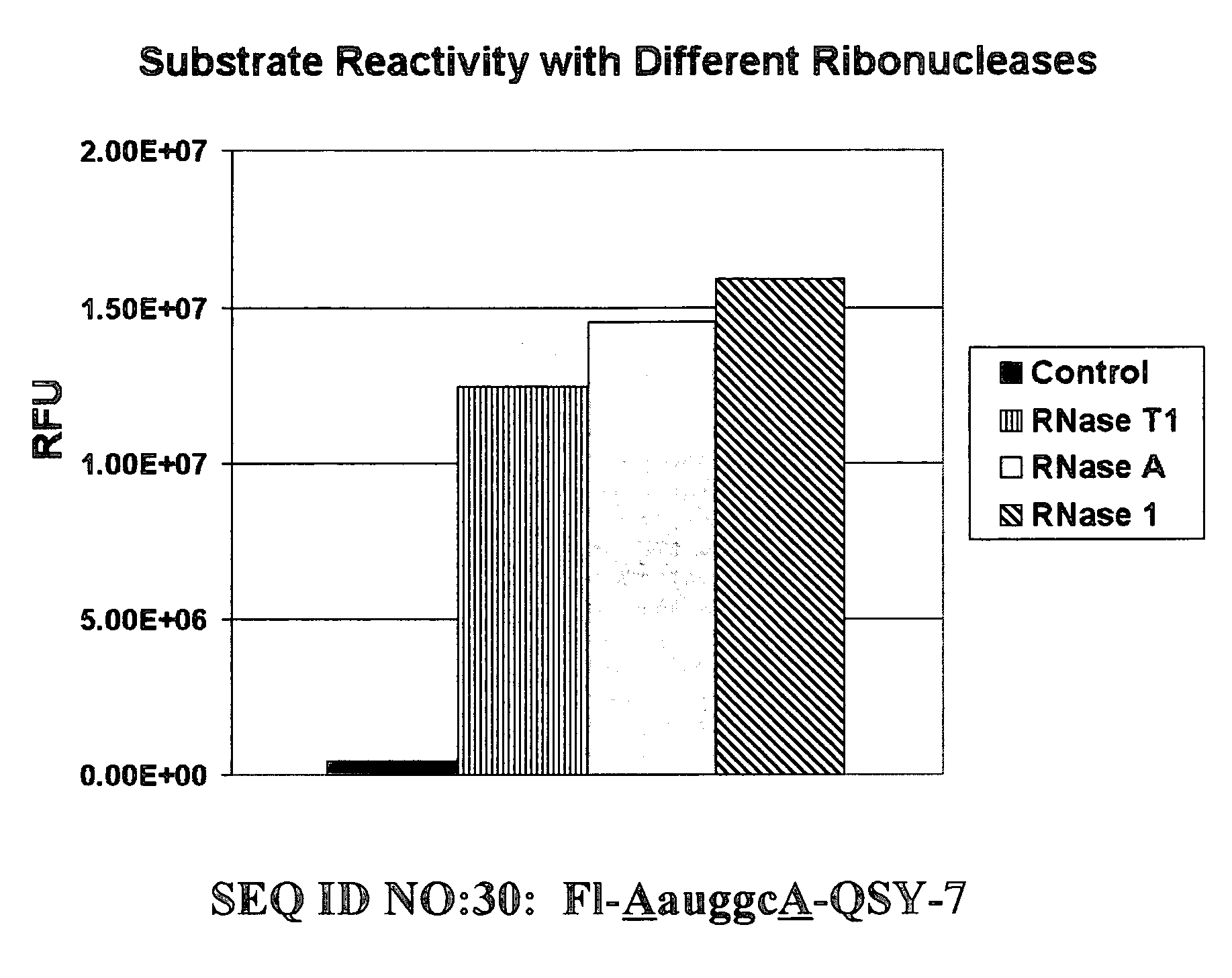Compositions and methods for visual ribonuclease detection assays
- Summary
- Abstract
- Description
- Claims
- Application Information
AI Technical Summary
Benefits of technology
Problems solved by technology
Method used
Image
Examples
example 1
6. EXAMPLE 1
Synthesis and Use of Synthetic Oligonucleotide Substrate in a Visual Detection Ribonuclease Assay
[0106] 6.1. Introduction
[0107] Synthesis of novel Substrate compositions that employ "dark quenchers" and their use in the visual RNase detection method of the invention is described.
[0108] 6.2. Materials and Methods
[0109] Oligonucleotide Synthesis: DNA .beta.-cyanoethyl (CE) phosphoramidites were obtained from Perkin Elmer (Foster City, Calif.). RNA and 2'-O-methyl RNA phosphoramidites were obtained from Proligo, Inc. (Boulder, Colo.). 5'-Fluorescein phosphoramidite (6-FAM, 6-carboxyfluorescein) and Amino-modifier-C7 CPG was obtained from Glen Research (Sterling, Va.). 6-Carboxytetramethyl-rhodamine succinimidyl-ester (6-Tamra-NHS-ester) and QSY.TM. 7 carboxylic acid, succinimidyl ester were obtained from Molecular Probes (Eugene, Oreg.). Sephadex G25 Nap-10 chromatography columns were obtained from Amersham Pharmacia Biotech (Piscataway, N.J.).
[0110] Equipment used to synth...
example 2
7. EXAMPLE 2
Reaction Specificity: DNase vs. RNase
[0128] 7.1. Introduction
[0129] It is desirable that Substrate(s) used in a ribonuclease assay be ribonuclease specific substrates. Compositions of the present invention do not contain residues susceptible to DNase attack. This example demonstrates that oligonucleotides that contain unmodified DNA, are cleaved by DNase while compositions of the present invention are RNase specific.
[0130] 7.2. Materials and Reagents
[0131] Reagents used to conduct the nuclease degradation experiments of this Example include oligonucleotides, DNase I, RNase A, nuclease-free water, and Buffer. Two oligonucleotides were employed, including:
4 SEQ ID NO:2: 5' Fluorescein-AuAA-Tamra 3' SEQ ID NO:3: 5' Fluorescein-AAuAA-Dabcyl 3'
[0132] Where: A=deoxyadenosine (DNA), u=uridine (RNA), and A=2'-O-methyl adenosine (2'-O-methyl RNA). SEQ ID NO:2 is a composition described by Kelemen (1999). Substrate SEQ ID NO:3 is a novel Substrate composition of this Example. Olig...
example 3
8. EXAMPLE 3
Reaction Specificity: Detection of Various Ribonuclease Enzymes
[0137] 8.1. Introduction
[0138] It is desirable that Substrate(s) used in a ribonuclease QC assay be sensitive to a broad range of ribonuclease activities. The present example demonstrates that a single Substrate can be designed that detects multiple ribonuclease enzymes.
[0139] 8.2. Materials and Reagents
[0140] Reagents used to conduct the nuclease degradation experiments of this Example include a Substrate oligonucleotide, enzymes, nuclease-free water, and Buffer. The Substrate oligonucleotides employed was:
[0141] SEQ ID NO:30: 5' Fluorescein-AauggcA-QSY-7 3'
[0142] Where: u=uridine, a=adenosine, g=guanosine, c=cytosine (RNA), and A=2'-O-methyl adenosine (2'-O-methyl RNA). Substrate SEQ ID NO:30 is the preferred Substrate of the invention as defined in Example 6.
[0143] Equipment used to conduct the nuclease detection experiments of this Example include a water bath set to 37.degree. C., aerosol-barrier micropi...
PUM
| Property | Measurement | Unit |
|---|---|---|
| Volume | aaaaa | aaaaa |
| Volume | aaaaa | aaaaa |
| Mass | aaaaa | aaaaa |
Abstract
Description
Claims
Application Information
 Login to View More
Login to View More - R&D
- Intellectual Property
- Life Sciences
- Materials
- Tech Scout
- Unparalleled Data Quality
- Higher Quality Content
- 60% Fewer Hallucinations
Browse by: Latest US Patents, China's latest patents, Technical Efficacy Thesaurus, Application Domain, Technology Topic, Popular Technical Reports.
© 2025 PatSnap. All rights reserved.Legal|Privacy policy|Modern Slavery Act Transparency Statement|Sitemap|About US| Contact US: help@patsnap.com



